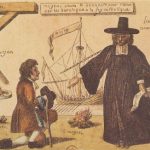For the Navajo and other tribes of the southwest, the tales of skinwalkers are not mere legend. Just ask Michael Stuhff. A Nevada attorney, Stuhff is likely one of the few lawyers in the history of American jurisprudence to file legal papers against a Navajo witch. He has often represented Native Americans in his practice. He understands Indian law and has earned the trust of his Native American clients, in large part because he knows and respects tribal religious beliefs.
As a young attorney in the mid-70s, Stuhff worked in a legal aid program based near Genado Arizona. Many, if not most, of his clients were Navajo. His legal confrontation with a witch occurred in a dispute over child custody and financial support. His client, a Navajo woman who lived on the reservation with her son, was asking for full custody rights and back child support payments from her estranged husband, an Apache man. At one point during the legal wrangling, the husband got permission to take the son out for an evening, but didn’t return the boy until the next day. The son later told his mother what had transpired that night.
According to the son, he spent the night with his father and a "medicine man." They built a fire atop a cliff and, for many hours, the medicine man performed ceremonies, songs, and incantations around the fire. As dawn broke, the three traveled into a wooded area near a cemetery, where they dug a hole. Into the hole, the medicine man deposited two dolls made of wood. One of the dolls was made of dark wood, the other of light wood. It was as if the two dolls were meant to represent the mother and her lawyer. Although Stuhff wasn’t sure how seriously to take the news, he recognized that it certainly didn’t sound good, so he sought out the advice of a Navajo professor at a nearby community college.
"He told me that the ceremony I had described was very powerful and very serious and that it meant that I was supposed to end up buried in that cemetery," Stuhff says. "He also said that a witch can perform this type of ceremony only four times in his life, because if he tries it more than that, the curse would come back on the witch himself. He also told me that if the intended victim found out about it, then the curse would come back onto the person who had requested it."
Stuhff thought about a way to let the husband know that he had found out about the ceremony, so he filed court papers that requested an injunction against the husband and the unknown medicine man, whom he described in the court documents as "John Doe, A Witch." The motion described in great detail the alleged ceremony. The opposing attorney appeared extremely upset by the motion, as did the husband and the presiding judge. The opposing lawyer argued to the court that the medicine man had performed "a blessing way ceremony," not a curse. But Stuhff knew that the judge, who was a Navajo, could distinguish between a blessing ceremony, which takes place in Navajo hogans (homes), and what was obviously a darker ceremony involving lookalike dolls that took place in the woods near a cemetery.
The judge nodded in agreement when Stuhff responded. Before the judge could rule, Stuhff requested a recess so that the significance of his legal motion could sink in. The next day, the husband capitulated by agreeing to grant total custody to the mother and to pay all back child support. "I took it very seriously because he took it seriously," Stuhff says. "I learned early on that sometimes witches will do things themselves to assist the supernatural, and I knew what that might mean."
Whether or not Stuhff literally believes that witches have supernatural powers, he acknowledges that this belief is strongly held in the Navajo nation. Certain communities on the reservation had reputations as witchcraft strongholds, he says. It is also unknown whether the witch he faced was a skinwalker or not. "Not all witches are skinwalkers," he says, "but all skinwalkers are witches. And skinwalkers are at the top. They are a witch’s witch, so to speak."








